Eating in Xiamen
Fujian Food Briefin
Fujian cuisine, recognized as one of China's eight major culinary traditions, has evolved through a fascinating fusion of Central Plains Han culture and indigenous Minyue culture. Originating in Fuzhou, this culinary tradition gradually incorporated regional variations from eastern, southern, western, northern Fujian, and Puxian areas, ultimately developing into three distinct schools: Fuzhou, Minnan, and Minxi cuisines.
The historical roots of Fujian cuisine stretch back over 5,000 years, shaped by the continuous exchange between Han culture and ancient Yue traditions. The cuisine experienced significant development during the Tang and Song dynasties, when northern migration patterns and the flourishing foreign trade in Fuzhou, Quanzhou, and Xiamen introduced new ingredients and cooking techniques. This rich historical background is evidenced by the Qing Dynasty text "Qingxiao Banknote," which listed Fujian among China's top ten culinary regions.
Fuzhou cuisine, as the mainstream representative of Fujian cuisine, enjoys widespread popularity not only in Fujian and Taiwan but also in Chinatowns worldwide. Its reputation as "Fuzhou cuisine's fragrance permeates the world, its culinary culture spanning ages" is well-deserved. The Song Dynasty's administrative division of Fujian into eight prefectures, known as Bamin, played a crucial role in shaping the cuisine's development. Fuzhou's strategic location as the province's political, economic, and cultural center facilitated the exchange of culinary traditions through various regional guildhalls, each promoting their local specialties.
Characterized by its emphasis on freshness, delicate flavors, and exquisite soups, Fujian cuisine stands out for its unique combination of land and sea ingredients. The culinary tradition's mastery lies in its sophisticated use of red fermentation and sweet-sour seasoning, creating dishes that are flavorful yet never greasy. This distinctive style, often compared to the eclectic Xiaoyao sect in Jin Yong's martial arts novels, skillfully incorporates the strengths of various culinary traditions while maintaining its unique identity.
Xiamen cuisine, as a prominent representative of Fujian culinary tradition, showcases the region's distinctive flavors and cooking techniques. The city's food culture has significantly influenced surrounding areas and gained national recognition, with signature dishes like oyster omelets and satay noodles achieving widespread fame. Beyond mere gastronomy, Xiamen's cuisine carries profound historical and cultural significance, with many dishes accompanied by captivating stories and legends.
Through continuous innovation and development, Xiamen cuisine has established four distinctive culinary pillars: seafood, snacks, vegetarian dishes, and medicinal cuisine. The city's culinary achievements have been recognized at national food festivals, with several Xiamen dishes earning the prestigious title of China's Famous Banquet, Famous Dishes, and Famous Snacks. Notable creations such as the East China Sea Jade Snail Fragrance, Crab Roe Braised Guan Yan, and South China Sea Golden Lotus have been officially included in China's catalog of renowned dishes, solidifying Xiamen's position as a culinary destination of national importance.
Famous Local Dishes
Shacha Noodles(Shacha Mian沙茶面)
In the streets and alleys of Southern Fujian, a unique noodle soup has captured the hearts of countless food lovers with its distinctive flavor - the renowned Shacha Noodles. The soul of this dish lies in its essential ingredient: Shacha sauce. Local chefs simmer this secret sauce into a rich broth, pairing it with springy oil noodles and garnishing with fresh bean sprouts, tender pork liver, and other accompaniments to create an unforgettable culinary experience.
The history of Shacha Noodles is a tale of cross-cultural culinary exchange across oceans. As one of China's earliest open coastal regions, Fujian's commercial ties with Southeast Asia laid the foundation for this dish's creation. The term "Shacha" (Satay) originates from Malaysia, though some scholars trace its roots to Indonesia. The Minnan people ingeniously transliterated the Malay "Sate" into "Shacha," preserving its exotic charm while giving it a local identity.
Today, Shacha Noodles have evolved into several regional varieties, with Minnan and Chaoshan styles being the most famous. Xiamen's Shacha Noodles stand out as a prime example, thanks to the dedication of Southern Fujian culinary master Yang Jibo. His direct disciple, chef technician Wang Daquan, not only inherited the traditional recipe but also elevated it to new heights.
The making of Shacha sauce is nothing short of an art form. Carefully selected ingredients including dried shrimp, dried fish, shallots, garlic, and ginger are expertly proportioned, fried to crispy perfection, then finely ground to create the aromatic Shacha sauce. This unique preparation process ensures that every bowl of Shacha Noodles carries the essence of the sea and the fragrance of the land.
Savoring an authentic bowl of Shacha Noodles is not just a gustatory delight but also a cultural journey across time and space. It bears witness to Fujian's historical role as a crucial hub on the Maritime Silk Road and showcases the Minnan people's inclusive and innovative culinary wisdom.
Muscovy duck(Jiangmu Ya姜母鸭)
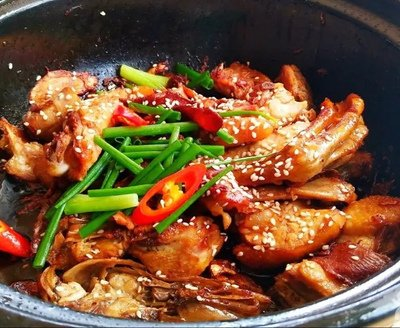
At the heart of this iconic Fujian dish lies the Muscovy duck, easily recognizable by its distinctive red face. The preparation begins with stir-frying the duck meat in fragrant sesame oil, followed by a slow braise with aged ginger (known as "ginger mother") and rice wine. This unique cooking process not only creates a flavorful dish but also unlocks its medicinal properties, believed to soothe the liver, nourish the lungs, strengthen the spleen, improve blood circulation, and relieve cold symptoms.
Served as a set meal reminiscent of Beijing's mutton hotpot, Xiamen Ginger Duck offers a complete dining experience. The main dish is accompanied by an array of side dishes that are cooked tableside, including duck heart, liver, gizzard, intestines, and blood, complemented by vermicelli, cabbage, and tofu bamboo. The meal typically concludes with noodles cooked in the rich, flavorful broth.
The dish's royal origins add to its allure. According to historical records in "Chinese Medicine" and "Chinese Pharmacopoeia," Ginger Mother Duck was originally a palace delicacy. Legend attributes its creation to Wu Zhong, a renowned physician during the Shang Dynasty. Over time, this royal recipe made its way to the common people, evolving into the beloved dish we know today.
Famous Local Snacks
Oyster omelette(Haili Jian海蛎煎)
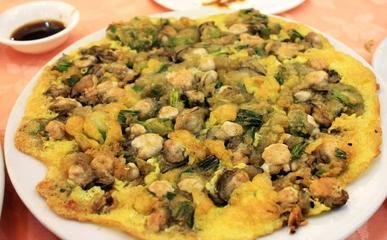
The oyster omelette, known locally as "Erajian" (a Xiamen dialect term for oyster pancake), stands as a quintessential Southern Fujian delicacy. This savory treat masterfully balances fragrance and texture, offering a delightful culinary experience.
The secret to a perfect oyster omelette lies in its preparation. While oysters naturally carry a briny essence, skilled chefs have perfected the art of preserving their umami richness while minimizing any overpowering fishiness. The key is in the egg application - rather than mixing eggs directly with the oysters (which can mask their natural flavor), chefs expertly encase the oysters in an egg blanket, allowing the seafood's essence to shine through.
Traditionally served with a medley of fresh scallions, garlic, and Xiamen's signature sweet chili sauce, this dish offers an irresistible combination of flavors and textures that keeps diners coming back for more.
The dish's origins are steeped in history. Legend traces its creation to 1661 AD, during Koxinga's (Zheng Chenggong) campaign to reclaim Taiwan from Dutch occupation. Facing food shortages after the Dutch sabotaged their grain supplies, Koxinga's resourceful troops improvised this dish using local ingredients: fresh oysters and sweet potato starch. What began as a wartime necessity evolved into a beloved culinary tradition, spreading from Taiwan to Fujian, Guangdong, and Zhejiang regions, each adding their unique local twist.
While regional variations exist, Xiamen's version remains particularly cherished for its perfect balance of flavors and its connection to this fascinating historical narrative.
Frozen Bamboo Shoots(Tusun Dong土笋冻)
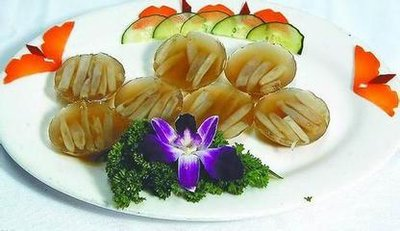
Frozen bamboo shoots is a special food originating in Quanzhou, Fujian Province. It is a kind of frozen product processed by unique products. It contains gum, the main raw material is a kind of worm, belongs to the asterozoa phylum, the scientific name is delicious leather capsule asterozoa, body length of two or three inches. After boiling, the jelly contained in the worm body is dissolved into water, and after cooling, it condenses into chunks, and its meat is clear and delicious.
One of the most representative snacks in Xiamen. "Earth bamboo shoot" the scientific name "star worm" produced in the beach sand, the practice is to remove the live earth bamboo shoot gut mud, wash it repeatedly, stew it into soup, pack small poison, and condense into a piece of exquisite small round after cooling. Serve cold and refreshing.
Earthworm jelly is a kind of circular animal fat round slender, like earthworm. Asparagus is rich in nutrition, adding a little when cooking, its soup taste sweet. But it is most praised as "earth and bamboo shoots frozen". The production method is: put the fresh earth bamboo shoots on the SLATE, press the viscera and impurities of the bamboo shoots, wash them and add water into the pot, burn them fiercely with fire, until the soup becomes gelatinous, and then put them in the container and freeze them. Pickled pickled cabbage, garlic white, crisp nori or hot and sour, soy sauce and other seasoning, the taste is better.
Earth bamboo shoots, also known as coating bamboo shoots, according to the "Min Xiaoji" said: "I often eat earth bamboo shoots frozen in Fujian, taste very fresh, but smell born in the seashore, like earthworms, that is, Sha Xun also." History is the most famous number of Quanzhou Anhai soil bamboo shoots frozen, taste very fresh, in the "Min Shao Ji" also recorded: "Painted bamboo shoots born in the beach sand hole, today Quanzhou sea cliff has production." Anhai produces the most today. Frozen bamboo shoots are grayish white, crystal transparent, fragrant crisp, elastic, and other spices with food, the flavor is particularly good, Quanzhou and even the pan-southern Fujian region of the winter and spring season seasonal delicacies.
The frozen bamboo shoot is delicious, and there are many theories about its origin. In the Anhai town rich in earth and frozen bamboo shoots west village, the villagers spread a legend: Ming Jiajing years, Qi Jiguang to Anhai to fight the Japanese, because of food shortage, the soldiers went to the beach to catch a kind of sea earthworms to cook soup. When Qi Jiguang finally had dinner, only the sea earthworm that had condensed into a gel was left, and he drew his sword to take off a piece to taste, and did not expect it to be more delicious than fish and crabs. After the chef knew it, he refined it in accordance with this method, and from then on, the earth and bamboo shoots were spread.
This is a folk saying, on the earth bamboo shoots written records, can be traced back to the Ming Dynasty. There are records in Ming Dynasty's "Minzhong Sea Wrong and Sparse", Xie Zhao's "Five Zaosers" at the end of Ming Dynasty, and Zhou Lianggong's "Min Xiao Ji" in Qing Dynasty. Zhou Lianggong's 1658 "Min Xiaoji" article recorded: "In Fujian, I often eat earth bamboo shoots frozen, taste very different, but I heard that it was born on the seashore, the shape of earthworms, and finally did not know what it was like." In this way, 350 years ago, bamboo shoots frozen has been a very popular street snack, Zhou Lianggong has become so far found the first person to describe the term "bamboo shoots frozen".
Frozen bamboo shoots in traditional Chinese medicine cold, sweet taste, salty, and frozen bamboo shoots rich in nutrients, rich in protein, amino acids, trace elements and other nutrients needed by the body, for people who are afraid of fire, eat some frozen bamboo shoots, not only can nourish the body, but also not afraid of fire. Especially in summer, eating some soil bamboo shoots can be very good to remove the anger in the body.
Stewed Pork Dumplings (Shao Rou Zong烧肉粽)
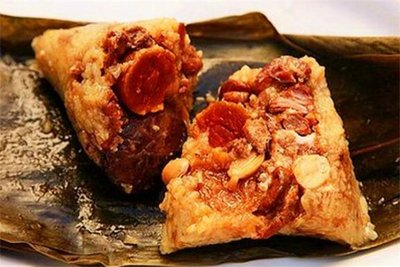
These pyramid-shaped delights are a true Xiamen specialty. Imagine glutinous rice perfectly blended with savory pork, earthy mushrooms, and briny dried shrimp, all seasoned with soy sauce and a hint of MSG. Wrapped meticulously in fragrant bamboo leaves and tied into their distinctive diamond shape, these dumplings are then simmered until the rice reaches that perfect tender consistency. Each bite offers a harmonious blend of textures and flavors that will transport you straight to the heart of Fujian cuisine.
Oil-scallion Cake (Youcong Guo油葱粿)
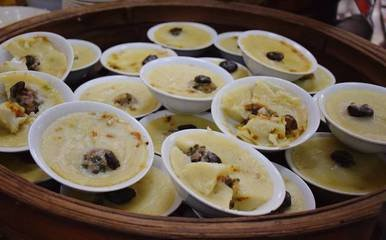
A delicate seafood cake that showcases Xiamen's coastal heritage. Fresh fish meat is combined with diced pork and crunchy water chestnuts, then enhanced with sweet potato starch, scallions, and a whisper of five-spice powder. Formed into balls and coated with rice starch, these cakes are steamed to perfection. The real magic happens when you sprinkle them with your choice of zesty Chinese condiments - perhaps some fiery chili paste or tangy pickled radish for that extra kick.
Stir-fry Upper Thread (Chao Mianxian炒面线)
A dish so unique to Xiamen that you'll be hard-pressed to find it elsewhere. Thin noodles are fried to a rich coffee color, then combined with a medley of pork, fresh fish, mushrooms, and bamboo shoots. The magic happens when the mixture is brought together with a flavorful broth, a splash of wine, and a pinch of MSG. The result? A dish that's as comforting as it is complex.
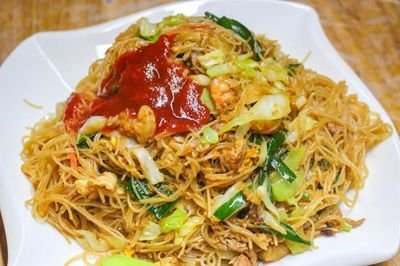
Recommended Restaurants
For your reference, the following are the restaurants rated most popular by the locals:
Huang Zehe Peanut Soup (Huang Zehe Huangsheng Tang黄则和花生汤店)
Address: No. 22-24, Zhongshan Road, Siming District, XiamenSpecialty: Established in 1945, famous for traditional peanut soup using ancient recipes. Offers various Minnan pastries and snacks, the best place to experience Xiamen's authentic flavors.
Jia Wei Zai Tian Snack Shop(Jiawei Zai Tian佳味再添小吃店)
Address: No. 49, Datong Road, Siming District, XiamenSpecialty:Established in 1956, known for affordable prices and quality. Offers over 50 types of traditional Xiamen snacks with daily fresh ingredients. Features an open kitchen for transparent food preparation.
Yuehua Shacha Noodles(Yuehua Shacha Mian月华沙茶面)
Address: No. 78, Zhenbang Road, Siming District, XiamenSpecialty:Established in 1980s, famous for secret shacha sauce. The broth is simmered for over 8 hours with 20+ spices. Offers 10+ topping choices for customized orders.
Ah Jie Wu Xiang (Chain)(A Jie Wu Xiang阿杰五香)
Address: Kaihe Road: No. 111, Kaihe Road, Siming DistrictKaihe Road: Inside Bashi Market, Kaihe Road
Specialty:Specializing in five-spice rolls for over 30 years using a secret family recipe. Freshly made daily with unique frying technique for crispy exterior and juicy filling, served with special sauce.
Lianhuan Oyster Omelette(Lianhuan Haili Jian莲欢海蛎煎)
Address: No. 10, Jukou Lane, Zhongshan Road, Siming DistrictSpecialty: Established in 1980s, famous for traditional oyster omelette. Uses fresh daily oysters with local sweet potato starch, crispy outside and tender inside. Unique double-sided frying technique enhances texture, served with special sweet chili sauce.
Fuyu Datong Duck Porridge(Fuyu Datong Yarou Zhou浮屿大同鸭肉粥)
Address: No. 174, Xiahe Road, Siming District, XiamenSpecialty: Established in 1980s, operates 24/7, famous for traditional duck porridge. Simmered for 8 hours, the porridge is smooth and the duck meat tender. Offers 20+ topping choices, perfect for late-night snacks.
Bashi Zhong Lijuan Pancakes(Bashi Zhong Lijun Manjian Gao八市钟丽君满煎膏)
Address: Inside Bashi Market, Kaihe Road, Siming District, XiamenSpecialty: Specializing in stuffed pancakes for over 30 years, using traditional handmade methods. Made with premium flour and fresh fillings, crispy outside and sweet inside. Offers various flavors, loved by locals.













